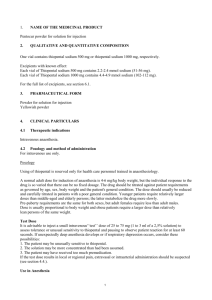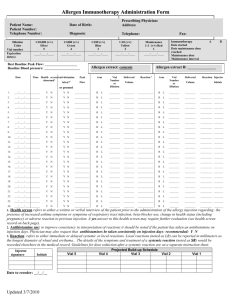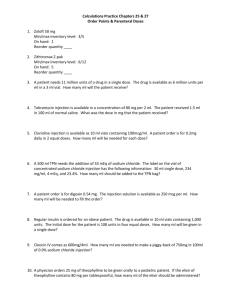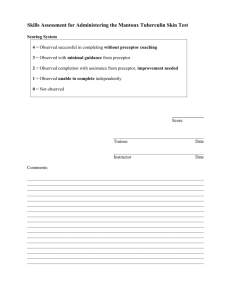Pentocur powder for solution for injection ENG PL
advertisement
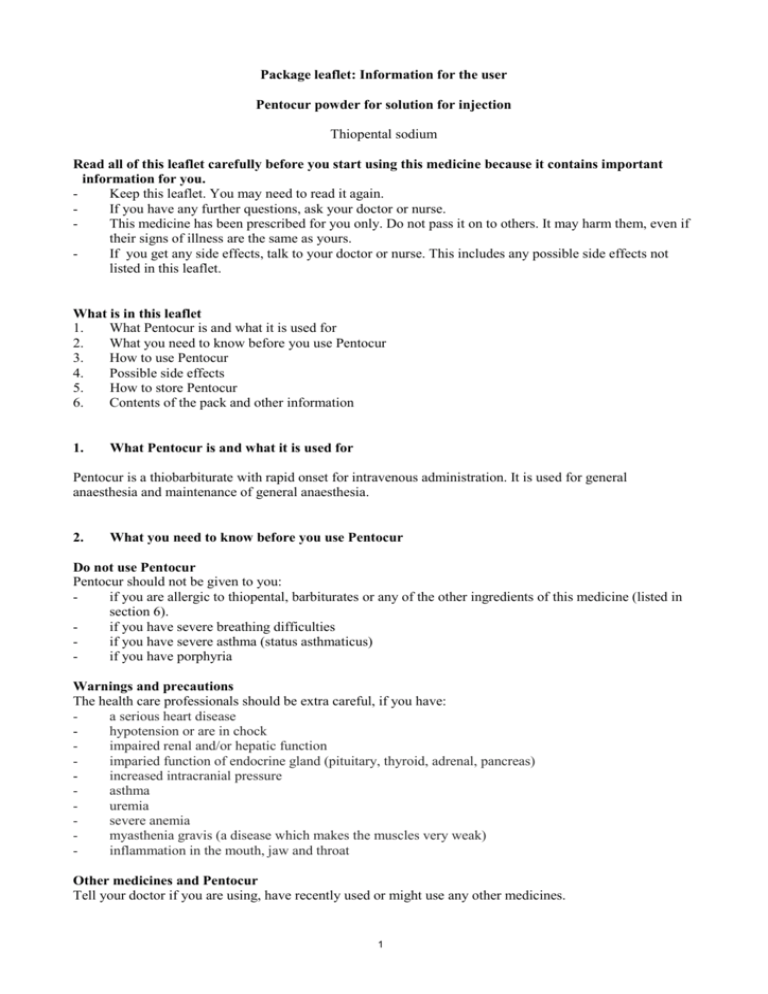
Package leaflet: Information for the user Pentocur powder for solution for injection Thiopental sodium Read all of this leaflet carefully before you start using this medicine because it contains important information for you. Keep this leaflet. You may need to read it again. If you have any further questions, ask your doctor or nurse. This medicine has been prescribed for you only. Do not pass it on to others. It may harm them, even if their signs of illness are the same as yours. If you get any side effects, talk to your doctor or nurse. This includes any possible side effects not listed in this leaflet. What is in this leaflet 1. What Pentocur is and what it is used for 2. What you need to know before you use Pentocur 3. How to use Pentocur 4. Possible side effects 5. How to store Pentocur 6. Contents of the pack and other information 1. What Pentocur is and what it is used for Pentocur is a thiobarbiturate with rapid onset for intravenous administration. It is used for general anaesthesia and maintenance of general anaesthesia. 2. What you need to know before you use Pentocur Do not use Pentocur Pentocur should not be given to you: if you are allergic to thiopental, barbiturates or any of the other ingredients of this medicine (listed in section 6). if you have severe breathing difficulties if you have severe asthma (status asthmaticus) if you have porphyria Warnings and precautions The health care professionals should be extra careful, if you have: a serious heart disease hypotension or are in chock impaired renal and/or hepatic function imparied function of endocrine gland (pituitary, thyroid, adrenal, pancreas) increased intracranial pressure asthma uremia severe anemia myasthenia gravis (a disease which makes the muscles very weak) inflammation in the mouth, jaw and throat Other medicines and Pentocur Tell your doctor if you are using, have recently used or might use any other medicines. 1 Remember to tell your doctor, if you use - Aminophylline (for the treatment of asthma) - Midazolam (a sedative drug) - Opioidanalgetics (strong painkillers) - Probenecid (a gout medicine) - Sufentanil (anesthetic agent) - Benzodiazepiner (for treating of anxiety) - Chloral hydrate (for treatment of insomnia) - Myorelaxantia (a muscle relaxant agent) - Valproat and MAO-inhibitors (antidepressing agents) - Metoclopramid (medicine for treating nausea) - Quetiapin (antipsycotic agent) - Medicines containing St John's Wort - Betablockers and calcium antagonists (for the treatment of high blood pressure) - Androgens (for treatment of male infertility) - Medicine for epilepsy - Felodipin (medicine for treatment of high blood pressure) - Glucocorticoides (antiinflammatory agents) - Metronidazol (medicine to treat bacterial infections) - Peroral anticoagulants (for thrombotic disorders) - Estrogen (for the treatment of menopauses) - Peroral antidiabetics (medicine for treatment of diabetics) - Theophyllin (for the treatment of lung diseases) Pregnancy, breast-feeding and fertility If you are pregnant or breast-feeding, think you may be pregnant or are planning to have a baby, ask your doctor for advice before taking this medicine. Pentocur should be given to a pregnant woman only if clearly needed. Thiopental is excreted to milk; breastfeeding should be temporarily suspended (at least 12 hours) and breast milk expressed before the use of Pentocur. Driving and using machines Patients must not drive and use machines within 24 hours after the use of Pentocur or within the time period determined by the doctor responsible for the treatment. Pentocur contains sodium One bottle of Pentocur 500 mg contains 2.2-2.4 mmol (51-56 mg) sodium. One bottle of Pentocur 1000 mg contains 4.4-4.9 mmol (102-112 mg) sodium. To be taken into consideration by patients on a controlled sodium diet. 3. How to use Pentocur Pentocur will be given to you by a healthcare professional according to your individual dose determined by your doctor. Tiopental will be given directly into one of your blood vessels, a vein (intravenously). If you use more Pentocur than you should It is unlikely that you receive an excessive dose, since healthcare personnel takes care of the administration of Pentocur. If you have any further questions on the use of this medicine, ask your doctor or nurse. 4. Possible side effects 2 Like all medicines, this medicine can cause side effects, although not everybody gets them. Common side effects (occur in less than 10 in 100 patients): Heart arrythmia Heart disorder Low blood pressure Sleepiness Delayed wakening from the anaesthesia Breathing difficulties Hyperventilation Difficulty in swallowing Coughing Snoring Shivering Rare side effects (occur in less than 1 in 1000 patients): Allergic reactions, such as rash, breathing difficulties, fall in the blood pressure and acute swelling of the skin (angioedema). Thiopental has been associated with reports of decreased potassium blood levels during infusion and increased potassium blood levels after stopping thiopental infusion. Reporting of side effects If you get any side effects, talk to your doctor or nurse. This includes any possible side effects not listed in this leaflet. You can also report side effects directly (see details below) By reporting side effects you can help provide more information on the safety of this medicine. [To be completed nationally] 5. How to store Pentocur Before the first opening: The medicinal product does not require any special storage conditions. After reconstitution: Store in a refrigerator (2 – 8°C) for maximum 24 hours. Store in room temperature for maximum 6 hours Keep this medicine out of the sight and reach of children. Do not use this medicine after the expiry date which is stated on the carton after EXP. The expiry date refers to the last day of the month. Do not throw away any medicines via wastewater or household waste. Ask your pharmacist how to throw away medicines you no longer use. These measures will help protect the environment. 6. Contents of the pack and other information What Pentocur contains - - The active substance is thiopental sodium. Each vial of Pentocur 0.5 g powder for solution for injection contains 500 mg thiopental sodium. Each vial of Pentocur 1 g powder for solution for injection contains 1000 mg thiopental sodium. The other ingredient is sodium carbonate. What Pentocur looks like and contents of the pack Glass vial with bromobuthyl rubber stopper, aluminium seal, in a carton box. 3 Content of the pack: Pentocur powder for solution for injection 0.5 g: 1 x 1vial, 10 x 1vial, 20 x 1 vial or 50 x 1 vial Pentocur powder for solution for injection 1 g: 1 x 1vial, 10 x 1vial, 20 x 1 vial or 50 x 1 vial Not all pack sizes may be marketed. Marketing Authorisation Holder and Manufacturer < To be completed nationally> This leaflet was last revised in <-----------------------------------------------------------------------------------------------------------------------------> The following information is intended for healthcare professionals only: Preparation of solution Pentocur powder for solution for injection should be prepared aseptically with one of the three following diluents: - Sterile Water for Injection - Sodium chloride 9 mg/ml (0.9%) - Dextrose 50 mg/ml (5%) Clinical concentrations used for intermittent intravenous administration vary between 2.0% and 5.0%. A 2.0% or 2.5% solution is most commonly used. A 3.4% concentration in sterile water for injection is isotonic; concentrations less than 2.0% in this diluent are not used because they cause hemolysis. For continuous intravenous drip administration, concentrations of 0.2% or 0.4% are used. Solutions may be prepared by adding thiopental to 5% water solution of dextrose or to 0.9% solution of sodium chloride. CALCULATIONS FOR VARIOUS CONCENTRATIONS Desired concentration Amounts to use % mg/ml g of Pentocur ml of diluent 0,2 2 1 500 0,4 4 1 250 2 500 2,0 20 5 250 10 500 2,5 25 1 40 5 200 5,0 50 1 20 5 100 Since Pentocur contains no added bacteriostatic agent, extreme care in preparation and handling should be exercised at all times to prevent the introduction of microbial contaminants. Solutions should be freshly prepared and used promptly; when reconstituted for administration to several patients; unused portions should be discarded after 24 hours. Sterilization by vapour should not be attempted. Pentocur is administered by the intravenous route only. Avoid extravasation or intra-arterial injection. A person qualified in the use of anesthetics should be constant available during the administration of the medicinal product. Keep endotracheal intubation equipment, oxygen and resuscitative equipment readily available. Any solution of Pentocur powder for solution for injection, with a visible precipitate should not be administered. 4 Incompatibilities: The stability of Pentocur powder for solution for injection solutions depends upon several factors, including the diluent, temperature of storage and the amount of carbon dioxide from room air that gains access to the solution. Any factor or condition which tends to lower pH (increase acidity) of Pentocur powder for solution for injection solutions will increase the likelihood of precipitation of thiopental acid. Such factors include the use of diluents which are too acidic and the absorption of carbon dioxide which can combine with water to form carbonic acid. Solutions of suxamethonium, tubocurarine or other drugs which have an acid pH should not be mixed with Pentocur powder for solution for injection solutions. The most stable solutions are those reconstituted in water and/or isotonic saline and/or solution of dextrose, kept under refrigeration and tightly stoppered. 5
